The Borzoi, also known as the Russian hunting sighthound, Russian greyhound, or Russkaya Psovaya Borzaya, stands out for its unique elegance and grace. Describing it as a long-haired, silky-coated greyhound would be spot on.
This majestic sighthound shares typical greyhound features, displaying long, slender legs, a streamlined body with a deep chest, defined abdomen, arched back, and a remarkably long tail. Its distinctive head is exceptionally long and narrow, contributing to its one-of-a-kind appearance. The Borzoi's grace is evident in every movement, highlighting its elegant and noble nature.
Although smaller than the Irish Wolfhound, the Borzoi still impresses with its imposing stature. Males reach a minimum height of 28 inches, while females have a minimum height of 26 inches. Currently, most males likely exceed 32-34 inches, with females slightly smaller. Their build is slender, resulting in less weight compared to their height. On average, males weigh between 75 and 105 pounds (34 to 47 kilograms), while females range from 60 to 85 pounds (27 to 38 kilograms). Their coat, whether curly or smooth, is long and somewhat silky, commonly appearing with white patches, although all colours are acceptable.
Used as a large Russian hunting sighthound, the Borzoi is distinguished not only by its impressive appearance but also by its affectionate, calm, and balanced personality. Despite displaying some stubbornness and selectiveness in its company, its affectionate nature makes it a loyal and cherished companion.
Origin
Borzoi have their roots in Russia.
Lifespan
On average, Borzoi live between 7-11 years.
Head:
Exceptionally long and narrow, well-proportioned.
Coat:
Long and somewhat silky, commonly with white patches, in various colours.
Weight
Males: Average weight is between 75 and 105 pounds (34-47 kilograms).
Females: Average weight is between 60 and 85 pounds (27-38 kilograms).
Height
Males: Typically between 32-34 inches at the shoulder, excluding the head.
Females: Slightly smaller, generally between 28-30 inches at the shoulder.
Temperament
Despite misconceptions, the Borzoi's temperament is genuinely calm
and composed.
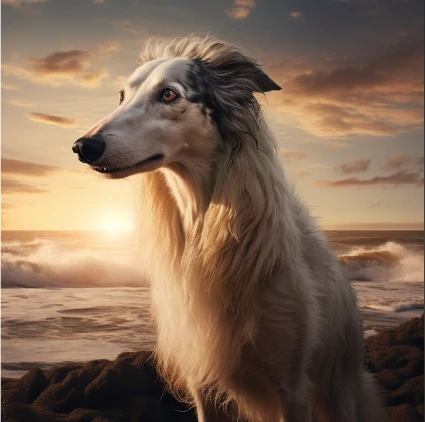
To catch the Russian wolf, a dog must glide like a greyhound. However, this greyhound would need to be covered in thick fur to shield it from icy winds, a coat likely inherited from Russia's shepherd dogs. It must be brave and robust, traits gained from crossbreeding with Russian wolf-hunting dogs. To capture the hearts of the Russian aristocracy, the dog would have to be beautiful, and the Borzoi's beauty surpasses that of any other breed.
The breed was in its formative stages in the Middle Ages; by the 16th century, the standard for the first breed was introduced. The Borzoi hunter was among the grandest events of hunting, often involving a massive procession of dogs, horses, servants, and nobility. Two or three paired Borzois were unleashed from their leashes with a wolf roused in the open; the Borzoi had to run swiftly to catch it before it reached cover on the other side of the field. Their job was to hold the wolf until the hunter tied it. Russian aristocracy maintained grand kennels of hundreds of Borzois. Most of these dogs were killed as symbols of hatred towards the Russian rulers after the Russian Revolution. Today's Borzoi descends from a few that escaped death, as well as from descendants of dogs given as gifts to foreign dignitaries.
In America, the Borzoi (initially known as the Russian wolf) found a second wave of fame with the aristocracy's model and became a status symbol. Those who personally knew the breed realized its great fame was due to being delightful companions.
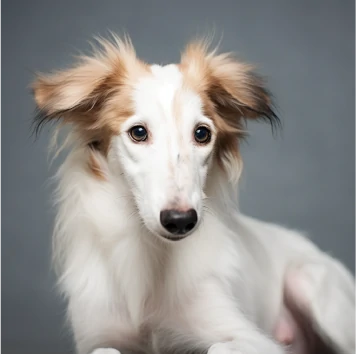
Embarking on the journey of raising a Borzoi pup demands a devoted approach, ideally suited for those with prior canine experience. A seasoned and attentive owner is indispensable for guiding the pup through essential training and socialization. Establishing a solid training foundation is paramount to ward off undesired behaviors and potential issues.
Initiating the Borzoi's education early on is key, involving deliberate socialization with a spectrum of individuals, other animals, and diverse environments. This crucial phase significantly shapes the dog's adult temperament, mitigating the risk of behavioral challenges like fear and aggression. Encouraging tranquility and positive conduct through affectionate gestures, kind words, and occasional rewards during this developmental stage is highly recommended.
When it comes to interactions, understanding the Borzoi's dynamics is crucial:
In summary, the Borzoi's puppy stage is a crucial period where thoughtful guidance and positive reinforcement lay the foundation for a well-rounded and harmonious adult companion in the Australian context.
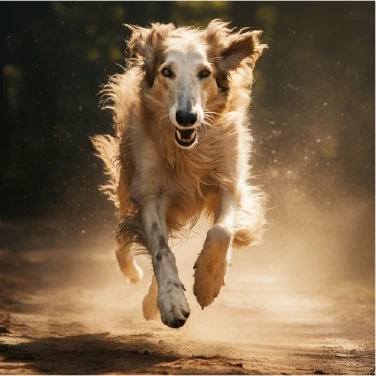
The Borzoi's character is marked by immense affection, primarily directed towards its owner and close social circle. They revel in tracking games that stimulate their keen sense of smell, showcasing their observant and serene nature. As a tranquil and balanced breed, the Borzoi, originally bred for hunting, tends to maintain a reserved demeanor with strangers, forming strong bonds with a singular person.
Determining the character of Borzoi dogs isn't straightforward, but in general, they exhibit a balanced and calm demeanor. However, the owner's provided training significantly shapes each individual's character, which can vary widely. Due to their history as hunting dogs, Borzois may display quick and impulsive reactions in certain situations.
While they may appear reserved and cautious with unfamiliar faces, within the family nucleus, Borzois forge exceptionally close bonds with their owners. Nevertheless, their interaction with others, be it people, animals, or environments, is directly influenced by their socialization stage. Owners must strive to provide positive and varied experiences, impacting their adult character.
Adaptable to diverse family setups, Borzois often thrive with experienced dog owners leading active and independent lifestyles. Unlike dogs known for strong attachment, Borzois exhibit a distinct character, requiring a unique approach in ownership.
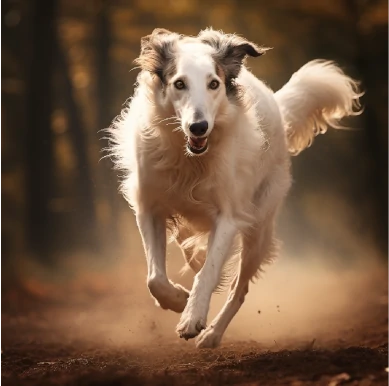
Healthy nutrition is paramount for Borzoi dogs, especially considering their large size. A well-balanced diet rich in proteins and healthy fats is essential for their overall well-being. Opting for high-quality commercial dog food, particularly those formulated for large breeds, is a wise choice for Borzois. These foods typically offer a blend of high-quality proteins, healthy carbohydrates, and essential fats.
Ensure your dog's food maintains an appropriate balance of nutrients. Most commercial dog food brands provide a nutritional label indicating protein, fat, and carbohydrate content. Carefully read the label and select a food containing high-quality proteins such as chicken, turkey, lamb, fish, or beef.
Foods to avoid:
Homemade meals for Borzoi:
If you prefer preparing your dog's meals at home, ensure it includes a balanced mix of high-quality proteins, carbohydrates, and healthy fats. Make sure your dog receives enough high-quality proteins from sources like lean meat, fish, and eggs. Healthy carbohydrates, such as vegetables and fruits, are also vital for your dog's well-being.
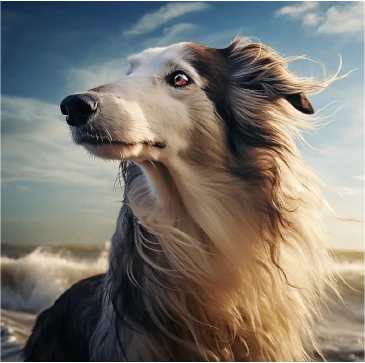
The Borzoi's coat requires regular care, and a consistent brushing routine is essential, ideally performed two or three times a week. This helps maintain a healthy and tangle-free coat. You can use a metal brush during shedding seasons (limited to once a week) and a soft slicker brush for the rest of the year. Detangling brushes can also be useful.
As for bathing, it is advisable to give your Borzoi a bath every one or two months. Use a dog-specific shampoo and, if possible, a conditioner to keep the coat soft and shiny.
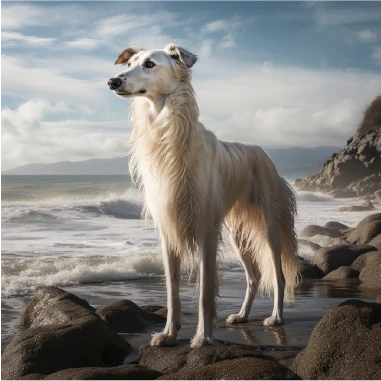
Your Borzoi should follow a balanced diet prescribed by your veterinarian. It's advisable to feed them a single meal in the evening to prevent gastric torsion.
Tendency to obesity: Given their high energy levels and slim build, it's unlikely for Borzois to become overweight. However, a balanced diet recommended by your veterinarian is crucial.
Common health issues:
Regular veterinary check-ups every 6 or 12 months are essential to ensure your dog receives proper preventive care. This includes following the vaccination schedule and deworming routine. Veterinary visits also help detect any pathology early, providing a better prognosis.
However, like many standardized dog breeds, Borzois are susceptible to various hereditary diseases, including:
We'll conclude this Borzoi breed profile with their life expectancy, which typically ranges from 7 to 12 years.